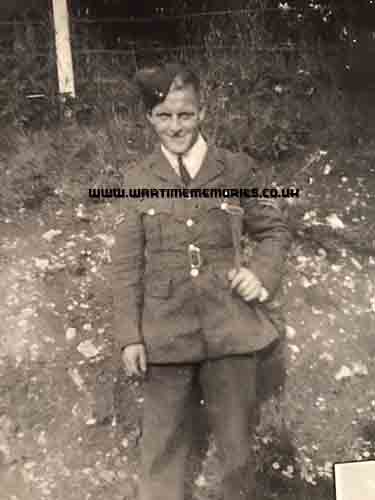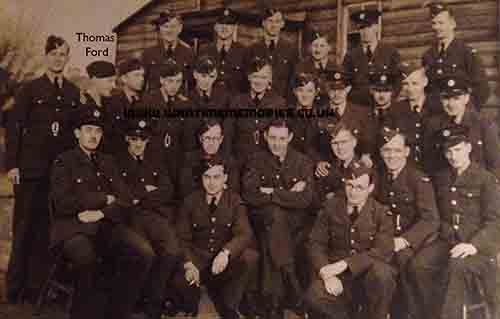Sgt. Thomas W. Ford
Royal Air Force 134 Squadron
from:Cherry Orchard Way, Maidstone, Kent
Thomas Ford loved radios. Before the war he taught himself how to build radios and sold them. In the Western Desert he found a rusty tin and made a radio from that. With the Chindits he was a Tropical Wireless Operator. After the war he worked on Currys televisions, fixed an unusable one and gave it to my aunt, who was one of the first in Maidstone to have a TV set. He got a job with Canadian Marconi in Newfoundland, installing ground radar on the DEWLINE - the Cold War early warning system, and stayed with Marconi for the rest of his life.
You'd think he'd have gone in for Wireless Operator/Fitter when he joined the RAF, but when he joined 134 Squadron (probably in 1940), he trained as a Fitter on Hurricanes. In July 1941, his squadron joined 81 squadron plus notable Battle of Britain pilots from 17 and 405 Squadrons to form 151 Wing. Their objective was to accompany about forty Hurricanes, some crated and some in the below-deck hangar, on two ships by convoy to Russia. Tom and his colleagues were tasked with unpacking the crated Hurricanes and reassembling them, and readying the planes for flight from the Erection ground at Keg Ostrov to the Russian Squadron's airfield of Vaenga. One of the huge crates became a temporary W/T Station at Keg Ostrov. Wonder if Tom was involved in that?
The hangared planes on the aircraft carrier were raised to the flight deck and flown to their new home. The RAF ground crews taught the Russian ground crews how to uncrate and reassemble Hurricanes for future consignments, and to how to repair and maintain the planes. The RAF pilots flew sorties against the attacking Luftwaffe and trained the Russian pilots to fly Hurricanes and to use that wonderful new weapon - radar. It snowed and everyone wore arctic gear, and the officers and crew were invited to vodka parties, and Tom apparently brought back some vodka glasses from this trip. It all sounds like a boys jolly, apart from the treacherous convoy journeys there and back.
A few months later in 1942, Tom's Squadron was sent to Egypt, where they worked in various Maintenance Units servicing other squadrons Hurricanes until the 134 Squadron planes arrived in December 1942. At some point Sgt Tom Ford and now converted to Spitfires, was photographed sitting on the tail of a captured ME 109 which may have been the Messerschmitt, which was subsequently repainted in RAF colours and flown on a few reconnaissance trips by an RAF pilot. 134 Squadron then moved to various locations in Tunisia until November, when it was sent to India and the Burmese border.
March 1943 - June 1945
Tom added his Wireless Operator's badge and Parachute wings and Burma gave him his Tropical Wireless Operator's badge. 134 Squadron Spitfires flew ground attacks against the Japanese in the Burmese jungle, but Tom wasn't with them all the time, he had volunteered to accompany the Chindits through the jungle, most likely for Operation Thursday, the second Chindits expedition in 1944.
He told my mother he had been behind enemy lines with the Chindits, but refused to say more, like many others he had witnessed such horrendous things that he shut it all away where it couldn't hurt, though he ground his teeth noisily in his sleep for the rest of his life. Nothing is known about which column he marched with but both Chindits operations had RAF Liaison Units accompanying each column. Tom would have used and carried (perhaps with the help of a mule?) ground to air radio equipment to communicate drop sites for Dakotas to drop ammunition and food by parachute into jungle clearings, and coordinating rendezvous at jungle airstrips for the wounded.
Unlike this image-driven age, where everyone records themselves on mobile phones, virtually nothing is known or shown of Tom and his comrades in their nightmare world of World War 2.

